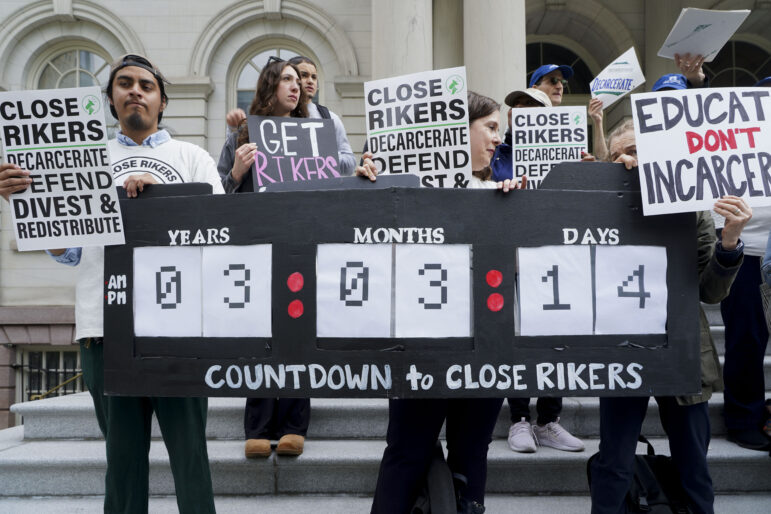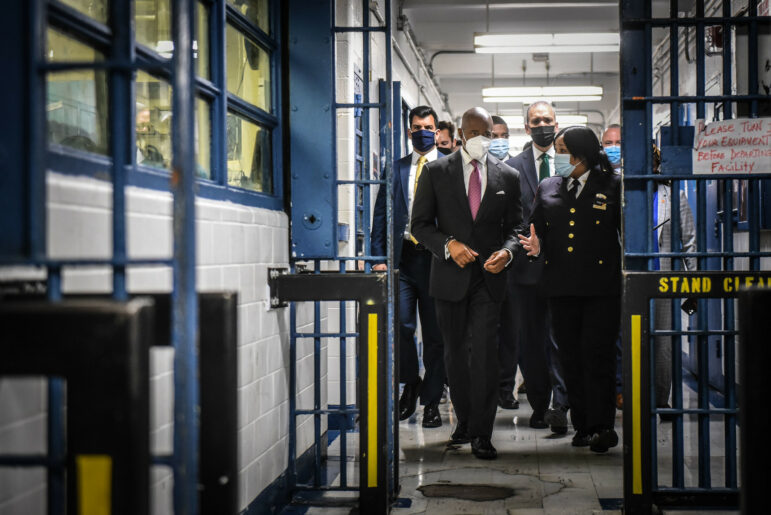Funding sought in this year’s budget, alongside updated eligibility criteria, could increase housing options for New Yorkers cycling between jail and shelter.

Gerard Romo/NYC Council media Unit
Advocates rallying ahead of the Department of Correction’s executive budget hearing May 17.An effort to increase housing options for New Yorkers cycling between jail and city shelters has stalled for more than three years—an impasse the City Council and criminal justice advocates hope to break in the impending city budget.
Meanwhile, a tweak to housing eligibility rules would open up an even broader universe of options for this population. Together the reforms could help drive down the city’s jail population, ahead of an impending 2027 deadline to shutter the notorious facilities on Rikers Island and replace them with four new jails.
“This mix of people—people who are cycling to the streets, to shelters, to Rikers, to hospitals and back again—our commission is really focused on trying to help stop that cycle,” said Zachary Katznelson, executive director of the Independent Rikers Commission tasked with helping the city meet its 2027 mandate.
“Housing, and supportive housing in particular, is an essential piece of that,” he added.
With $6.4 million in new, annual funding starting July 1, Mayor Eric Adams’ administration could grow the city’s Justice Involved Supportive Housing (JISH) program from 120 beds to 500, according to analysis by the Corporation for Supportive Housing (CSH), a nonprofit lender and industry advocate.
The City Council has included JISH in its budget priorities for three years running. “If the administration is serious about strengthening public safety and reducing recidivism and homelessness, then it must prioritize investments for JISH in the budget to address its underfunding that has left hundreds of housing units unfulfilled,” a spokesperson said.
Supportive housing is geared to people who have experienced homelessness, and have a mental illness or substance use disorder. Through JISH, launched in 2015, tenants with frequent shelter and jail stays are matched with a case manager to help them navigate court dates and healthcare appointments, and adjust to living independently.
The Fortune Society is currently contracted to house 60 JISH tenants, while two other nonprofits, Urban Pathways and CAMBA, have 30 each. All use the scattered-site model, renting apartments in privately-owned buildings and subletting them to their tenants.
Providers say the city’s existing funding is inadequate. The annual increase sought—equivalent to less than one percent of the Department of Correction’s anticipated budget for the upcoming fiscal year—would boost service funding to $25,596 per client per year, matching funding for certain young adults in NYC 15/15, another supportive housing program.
JISH tenants, like homeless youth, face a “complex set of challenges,” according to Lily Shapiro, policy counsel at The Fortune Society. As it stands, providers are “leaning on other funding sources.”
Urban Pathways, for example, uses a grant-funded psychiatrist. The organization has two case managers for its JISH tenants but would prefer two more. Deputy Executive Director Lisa Lombardi said it can be hard to work with clients who are geographically spread out and aren’t accustomed to living on their own, sometimes “resisting” services.
The new funding would also sweeten an outstanding 2019 Request for Proposal (RFP) for 380 more JISH beds—either rented or purpose-built—which hasn’t drawn much interest, despite a 2023 amendment increasing rent reimbursements.
“At the current rate I don’t foresee us bidding on more than the 30 units we have,” said Nicole McVinua, policy director at Urban Pathways.
In October, homeless services provider Project Renewal got the first award from the 2019 RFP—$10.69 million over nine years for 24 units, defined as either studios, one-bedrooms, or half of a two-bedroom.
But the organization returned the funding in November. Project Renewal declined an interview request, but confirmed that the contract ultimately didn’t make financial sense.
Funding aside, current JISH providers have also criticized the program’s referral system. Most supportive housing applicants must sit for interviews, which critics say are overly subjective. But for JISH, the city issues a list of people who automatically qualify—a process providers have called blunt and imperfectly coordinated.
The Department of Health and Mental Hygiene, which administers the JISH program, declined to comment on open RFPs. As for the $6.4 million request, a spokesperson said the budget process is ongoing in collaboration with the City Council. The agency added $20 million in supportive housing funding in January, albeit not for JISH.
The Council is also seeking a dedicated budget line-item for JISH, to make it easier to track from year to year—a practice the health department said is not typical for individual programs.

Michael Appleton/Mayoral Photography Office
Mayor Eric Adams during a tour of Rikers in 2022.There are currently hundreds of supportive housing apartments in New York City set aside for people with justice system history, with various funding sources. The City Council recently voted to limit landlords’ review of criminal background checks in screening tenants, and city guidance prohibits supportive housing providers from using them.
But JISH is unique in that it does not require a person to meet the federal definition of chronic homelessness—unhoused for extended periods without a jail stay over 90 days.
“Folks could have been homeless for 10 years before they were incarcerated, but if they’re on Rikers Island for 91 days they’re no longer considered chronically homeless,” said McVinua of Urban Pathways. “And so they’re going to end up going to shelter when they get out if they don’t get into a JISH bed.”
“And then the reality is that they have to wait in that shelter for a year to be considered chronically homeless and then they end up in… another form of supportive housing anyway once they hit that point,” she added.
CSH has estimated that more than 2,500 people on Rikers over a one-year period could benefit from supportive housing, but about 70 percent are not chronically homeless.
One way to help this population would be to change the eligibility rules for NYC 15/15, which aims to create 15,000 units of supportive housing by 2030. Currently, most single people and families must be chronically homeless to qualify.
The city has issued contracts for over 7,900 15/15 units to date, according to the Department of Social Services (DSS), far surpassing JISH. Most will be in purpose-built supportive housing buildings, where 2,761 units have opened so far.
The funded scattered-site units—1,300 of them—aren’t all operational because providers have had some difficulty finding apartments in a historically tight market, a DSS spokesperson said.
Manhattan Councilmember Carlina Rivera is planning to introduce legislation as soon as next month to modify qualifications for NYC 15/15 and any future supportive housing program entirely funded by the city, she told City Limits this week.
“[It] would say that the time spent incarcerated counts as homelessness,” she said. “Or figure out how to waive the chronicity requirement for this population altogether. It’s just such an unnecessary barrier.”
Mayor Adams also expressed interest in a modification this week, answering a question City Limits posed at his regular off-topic press conference.
“I think that the definition of homeless should include incarceration,” he said. “One of the problems that we have is that, those who are re-entering society, oftentimes we don’t have a landing for them.”
“We need to really look at that because that creates a level of desperation,” he continued. “Our team is going to look at that and see what modifications we can make. I don’t consider incarceration as being a home and being housed.”

Ed Reed/Mayoral Photography Office
Mayor Adams taking questions at his weekly off-topic press conference on May 21.There are currently about 6,300 people incarcerated at Rikers Island, James Saunders, deputy commissioner of health affairs at the Department of Correction (DOC), testified at a May 17 budget hearing. More than 50 percent of that population has received mental health treatment, and about 20 percent have a serious mental health diagnosis.
Earlier this year, over a quarter of patients with Correctional Health Services, which provides care in the city’s jails, reported that they were homeless prior to incarceration or anticipated being homeless after.
“If [judges] had real supportive housing options in the community, we’ve been told time and again… they’d be much more inclined to release people rather than send them to jail,” said Katznelson of the Independent Rikers Commission.
The city’s average daily jail population has been ticking up during the Adams administration, according to a tracker maintained by Comptroller Brad Lander: from 5,559 in the fiscal year ending in June 2022 to 5,873 the following year.
The administration has also increased the number of beds planned for the four new jails set to replace Rikers, from 886 to 1,040 each. New contracts to construct the Bronx and Queens facilities extend into 2031, years after Rikers is supposed to close.
The prior plan raised “serious questions about the city’s ability to keep New Yorkers safe,” mayoral spokesperson Liz Garcia said in a statement to City Limits.
City Hall remains “committed to completing the borough-based jails, which is what we must do to protect public safety, provide humane conditions for those in custody, and close the jails on Rikers Island,” she added.
Having housing available for people leaving jail is key to achieving this goal, according to Victor Herrera, an organizer with Freedom Agenda, an anti-carceral organization with the Close Rikers campaign.
Herrera’s brother has been on Rikers Island for over a year, he said, and was in shelter prior to that. “The [shelter] case managers are overloaded so individuals fall through the cracks,” he said. “They get lost and go right back into the system.”
Herrera himself left prison in 2001. Though he later spent time in a shelter, he initially moved in with family.
“When [people] have no place to go and they’re looking at either the streets or shelter, that’s stress on them, a very heavy stress,” Herrera said. “For me it eased my mind because I knew I was going someplace.”
To reach the reporter behind this story, contact Emma@citylimits.org. To reach the editor, contact Jeanmarie@citylimits.org
Want to republish this story? Find City Limits’ reprint policy here.







